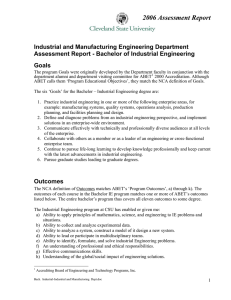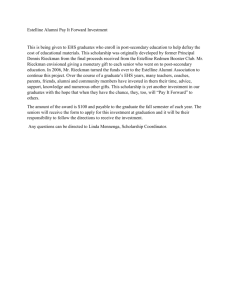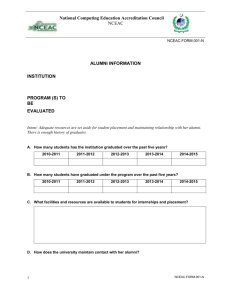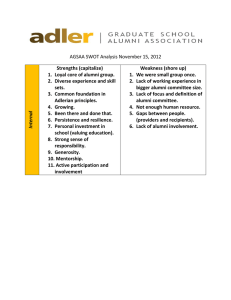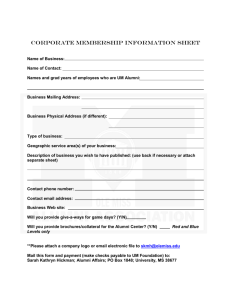2006 Assessment Report
advertisement
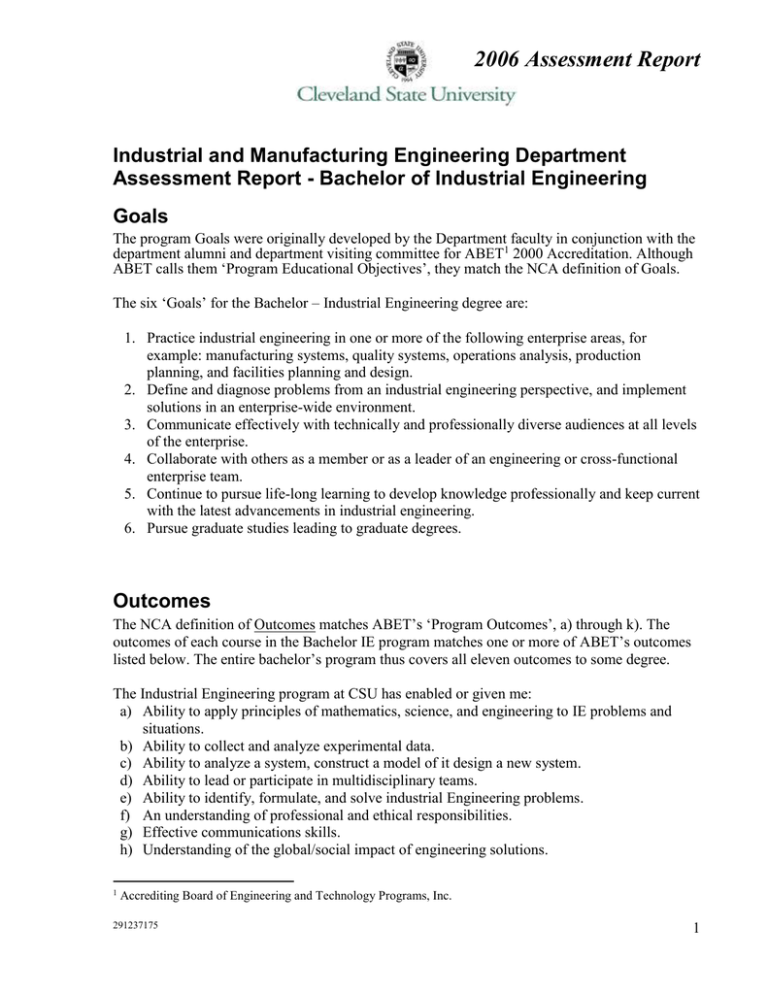
2006 Assessment Report Industrial and Manufacturing Engineering Department Assessment Report - Bachelor of Industrial Engineering Goals The program Goals were originally developed by the Department faculty in conjunction with the department alumni and department visiting committee for ABET1 2000 Accreditation. Although ABET calls them ‘Program Educational Objectives’, they match the NCA definition of Goals. The six ‘Goals’ for the Bachelor – Industrial Engineering degree are: 1. Practice industrial engineering in one or more of the following enterprise areas, for example: manufacturing systems, quality systems, operations analysis, production planning, and facilities planning and design. 2. Define and diagnose problems from an industrial engineering perspective, and implement solutions in an enterprise-wide environment. 3. Communicate effectively with technically and professionally diverse audiences at all levels of the enterprise. 4. Collaborate with others as a member or as a leader of an engineering or cross-functional enterprise team. 5. Continue to pursue life-long learning to develop knowledge professionally and keep current with the latest advancements in industrial engineering. 6. Pursue graduate studies leading to graduate degrees. Outcomes The NCA definition of Outcomes matches ABET’s ‘Program Outcomes’, a) through k). The outcomes of each course in the Bachelor IE program matches one or more of ABET’s outcomes listed below. The entire bachelor’s program thus covers all eleven outcomes to some degree. The Industrial Engineering program at CSU has enabled or given me: a) Ability to apply principles of mathematics, science, and engineering to IE problems and situations. b) Ability to collect and analyze experimental data. c) Ability to analyze a system, construct a model of it design a new system. d) Ability to lead or participate in multidisciplinary teams. e) Ability to identify, formulate, and solve industrial Engineering problems. f) An understanding of professional and ethical responsibilities. g) Effective communications skills. h) Understanding of the global/social impact of engineering solutions. 1 Accrediting Board of Engineering and Technology Programs, Inc. 291237175 1 2006 Assessment Report i) Commitment to engage in lifelong learning. j) Knowledge of contemporary issues. k) Ability to apply techniques, skills, and modern engineering tools and practices to IE problems and situations. Scoring Scoring is measuring the level of achievement of the program outcomes and goals. Currently the undergraduate students are surveyed for the achievement of the program outcomes, and the alumni are surveyed for the attainment of the goals. The relationship between goals and outcomes is shown in the Goals-Outcomes table on page 9 of this report. 291237175 2 2006 Assessment Report b) c) d) e) f) g) h) i) j) k) Overall average 5 4 2 1 14 93 2 1 14 93 2 1 14 93 1 1 12 80 2 1 14 93 1 2 13 87 2 1 14 93 2 1 14 93 2 15 13 100 87 15 100 Strongly Disagree Percentage of Total a) Outcomes Weights ability to apply principles of mathematics, science, and engineering to IE problems and situations. ability to collect and analyze experimental data. ability to analyze a system, construct a model of it design a new system. ability to lead or participate in multidisciplinary teams. ability to identify, formulate, and solve industrial engineering problems. an understanding of professional and ethical responsibilities. effective communications skills. an understanding of the global/social impact of engineering solutions. commitment to engage in lifelong learning. knowledge of contemporary issues. ability to apply techniques, skills, and modern engineering tools and practices to IE problems and situations. Total Points Strongly Agree In my studies for the Bachelors of Industrial Engineering at Cleveland State University, I: Weighted Total 2006 Senior Exit Survey and Analysis 3 1 3 1 3 21 11 1 2 1 152 13.8 Calculations: The weighted total column represents the weighted response for each question. It was calculated as follows: The maximum number of points for any question would have been the number of responses times 5—in this case 3 X 5 = 15. The actual weighted total for question 1 is 14. Therefore the Percentage of Total is 93%. Comments: The results indicate that the program outcomes are being achieved to a high level, except for working in multidisciplinary teams. Except for the Senior Design experience when conducted in a real world environment, undergraduate students have little opportunity to work in multidisciplinary teams. 291237175 3 2006 Assessment Report 2006 Alumni Survey and Analysis The Fenn College Dean’s office initiated the 2006 Alumni Survey, and queried the Industrial Engineering alumni, from 2000 through 2005. We received 11 responses, which are summarized in the stem-leaf plots in the next section. Responses to query 1 of the alumni survey form showed the respondents work in all 8 of the areas listed (below), plus two who work in the areas of safety and environmental or occupational health. 1) manufacturing systems 2) quality and/or reliability systems 3) operations analysis 4) production planning and scheduling 5) facilities planning 6) product and/or process design 7) management and/or supervision 8) marketing and/or sales Responses to query 2 through 6 are displayed in stem-leaf plots; the advantage being, for small samples (such as this) the raw data can be read from the plot, which is a histogram that has been rotated 90 degrees clockwise from the horizontal. Although they contain a wealth of information, stem-leaf plots can be difficult to interpret. Therefore, we interpret one of the results. Generally, column 1 of the stem-leaf plot is the number of datum before the median (identified by the counted number of datum at the median; in parentheses); column 2 is the stem (the left most digit in the datum) and column 3 is the leaf (the first digit to the right of the decimal point in the datum). For example, 3 3 000 in the stem-leaf plot of query 2 means that 3 data points occur before the median which is 4.0, (7) of the points are at the median, and the three datum are 3.0, 3.0 and 3.0. Interpreting the meaning of this result; the seven 4.0s signify that seven alumni indicate this objective was met at the level 4 (‘Very Well’ accomplished). Going on to interpret all responses to query 2 (the accomplishment of objective 2) we have 3 alumni who considered objective 2 ‘Moderately’ well accomplished, 7 alumni considered objective 2 ‘Very Well’ accomplished, and 1 alumni considered the level of accomplishment of objective 2 ‘Excellent’. Note that all objectives 2 through 5 are mostly considered ‘Moderately’ or ‘Very Well’ accomplished. Only objective 6 concerning pursuit of graduate studies, is not well accomplished. Here the distribution is bimodal with the majority of the alumni, not pursuing graduate degrees. 291237175 4 2006 Assessment Report Alumni Survey Stem-Leaf Plots My education at Fenn College of Engineering has enabled me to Stem-and-leaf of query 2 Leaf N = 11, Leaf Unit = 0.10 2. Define and diagnose problems from an industrial engineering perspective, and implement solutions in an enterprise-wide environment. 3 3 000 (7) 4 0000000 1 5 0 Stem-and-leaf of query 3 N = 11, Leaf Unit = 0.10 1 3 (5) 3 2 3 4 5 3. Communicate effectively with technically and professionally diverse audiences at all levels of the enterprise. 4. Collaborate with others as a member or as a 0 00 00000 000 Stem-and-leaf of query 4 leader of an engineering or cross-functional enterprise N = 11, Leaf Unit = 0.10 team. 1 1 (6) 4 2 0 3 4 000000 5 0000 Stem-and-leaf of query 5 N = 11, Leaf Unit = 0.10 5. Continue to pursue life-long learning to develop knowledge professionally and keep current with the latest advancements in industrial engineering. 1 5 (4) 2 2 3 4 5 0 0000 0000 00 291237175 5 2006 Assessment Report Stem-and-leaf of query 6 6. Pursue graduate studies leading to graduate degrees N = 11, Leaf Unit = 0.10 (6) 0 000000 5 1 5 2 5 3 0 4 4 00 2 5 00 291237175 6 1. To produce graduates who are able to practice Industrial Engineering in enterprise areas such as: manufacturing systems, quality systems, operations analysis, production X planning, or facilities planning and design 2. To produce graduates who are able to define and diagnose problems from an industrial engineering perspective, and implement solutions in an enterprisewide environment 3. To produce graduates who are able to communicate effectively with technically and professionally diverse audiences at all levels of the enterprise X 291237175 X X X X X X X X X (k) Ability to apply techniques, skills and modern engineering tools and practices to IE problems and situations (j) Knowledge of contemporary issues (i) Commitment to engage in lifelong learning X X X X (h) Understanding of the global/social impact of engineering solutions X X X (g) Effective communication skills (f) Understanding of professional and ethical responsibilities (e) Ability to identify, formulate, and solve Industrial Engineering problems X 4. To produce graduates who are able to collaborate with others as a member or as a leader of an engineering or cross-functional enterprise team 5. To produce graduates who are able to continue to pursue lifelong learning to develop professionally and keep current with the latest advancements in industrial engineering 6. To produce graduates who are able to pursue graduate studies leading to graduate degrees (d) Ability to lead or participate in multidisciplinary team work Goals (c) Ability to analyze a system, construct a model of it, and design a new system Outcomes (a) Ability to apply principles of mathematics, science and engineering to IE problems and situations (b) Ability to collect and analyze experimental data 20006 Assessment Report X X X X X 7

